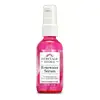What's inside
What's inside
 Key Ingredients
Key Ingredients

 Benefits
Benefits

 Concerns
Concerns

 Ingredients Side-by-side
Ingredients Side-by-side

Water
Skin ConditioningRosa Damascena Flower Water
MaskingCoco-Caprylate/Caprate
EmollientC9-12 Alkane
SolventPropanediol
SolventEthylhexyl Palmitate
EmollientPentylene Glycol
Skin ConditioningGlycerin
HumectantSqualane
EmollientRosa Damascena Flower Extract
MaskingRosa Damascena Extract
MaskingCamelina Sativa Seed Oil
Skin ConditioningRosa Rubiginosa Seed Oil
EmollientCucumis Sativus Fruit Extract
EmollientRosa Damascena Flower Oil
MaskingTocopherol
AntioxidantSodium Citrate
BufferingSodium Chloride
MaskingEthylhexylglycerin
Skin ConditioningXanthan Gum
EmulsifyingCitric Acid
BufferingCaprylic/Capric Triglyceride
MaskingSorbitan Sesquioleate
Emulsifying1,2-Hexanediol
Skin ConditioningCaprylyl Glycol
EmollientSodium Benzoate
MaskingPotassium Sorbate
PreservativeCitronellol
PerfumingGeraniol
PerfumingWater, Rosa Damascena Flower Water, Coco-Caprylate/Caprate, C9-12 Alkane, Propanediol, Ethylhexyl Palmitate, Pentylene Glycol, Glycerin, Squalane, Rosa Damascena Flower Extract, Rosa Damascena Extract, Camelina Sativa Seed Oil, Rosa Rubiginosa Seed Oil, Cucumis Sativus Fruit Extract, Rosa Damascena Flower Oil, Tocopherol, Sodium Citrate, Sodium Chloride, Ethylhexylglycerin, Xanthan Gum, Citric Acid, Caprylic/Capric Triglyceride, Sorbitan Sesquioleate, 1,2-Hexanediol, Caprylyl Glycol, Sodium Benzoate, Potassium Sorbate, Citronellol, Geraniol
 Reviews
Reviews

Ingredients Explained
These ingredients are found in both products.
Ingredients higher up in an ingredient list are typically present in a larger amount.
Citric Acid is an alpha hydroxy acid (AHA) naturally found in citrus fruits like oranges, lemons, and limes.
Like other AHAs, citric acid can exfoliate skin by breaking down the bonds that hold dead skin cells together. This helps reveal smoother and brighter skin underneath.
However, this exfoliating effect only happens at high concentrations (20%) which can be hard to find in cosmetic products.
Due to this, citric acid is usually included in small amounts as a pH adjuster. This helps keep products slightly more acidic and compatible with skin's natural pH.
In skincare formulas, citric acid can:
While it can provide some skin benefits, research shows lactic acid and glycolic acid are generally more effective and less irritating exfoliants.
Most citric acid used in skincare today is made by fermenting sugars (usually from molasses). This synthetic version is identical to the natural citrus form but easier to stabilize and use in formulations.
Read more about some other popular AHA's here:
Learn more about Citric AcidGlycerin is already naturally found in your skin. It helps moisturize and protect your skin.
A study from 2016 found glycerin to be more effective as a humectant than AHAs and hyaluronic acid.
As a humectant, it helps the skin stay hydrated by pulling moisture to your skin. The low molecular weight of glycerin allows it to pull moisture into the deeper layers of your skin.
Hydrated skin improves your skin barrier; Your skin barrier helps protect against irritants and bacteria.
Glycerin has also been found to have antimicrobial and antiviral properties. Due to these properties, glycerin is often used in wound and burn treatments.
In cosmetics, glycerin is usually derived from plants such as soybean or palm. However, it can also be sourced from animals, such as tallow or animal fat.
This ingredient is organic, colorless, odorless, and non-toxic.
Glycerin is the name for this ingredient in American English. British English uses Glycerol/Glycerine.
Learn more about GlycerinPotassium Sorbate is a preservative used to prevent yeast and mold in products. It is commonly found in both cosmetic and food products.
This ingredient comes from potassium salt derived from sorbic acid. Sorbic acid is a natural antibiotic and effective against fungus.
Both potassium sorbate and sorbic acid can be found in baked goods, cheeses, dried meats, dried fruit, ice cream, pickles, wine, yogurt, and more.
You'll often find this ingredient used with other preservatives.
Learn more about Potassium SorbateRosa Damascena Flower Oil is an essential oil made from the Damask Rose. It is often used as a fragrance in cosmetics.
Rose Oil has antibacterial and antioxidant properties due to its terpene, glycoside, flavonoid, anthocyanin, and Vitamin C content.
Other major parts of Rose Oil include citronellol and geraniol. Both of these are known EU allergens and cause contact-allergies.
The downsides of this ingredient outweight the positives.
Learn more about Rosa Damascena Flower OilWater. It's the most common cosmetic ingredient of all. You'll usually see it at the top of ingredient lists, meaning that it makes up the largest part of the product.
So why is it so popular? Water most often acts as a solvent - this means that it helps dissolve other ingredients into the formulation.
You'll also recognize water as that liquid we all need to stay alive. If you see this, drink a glass of water. Stay hydrated!
Learn more about Water